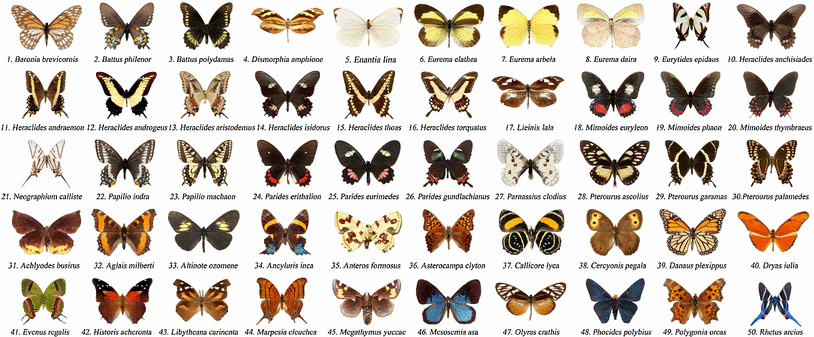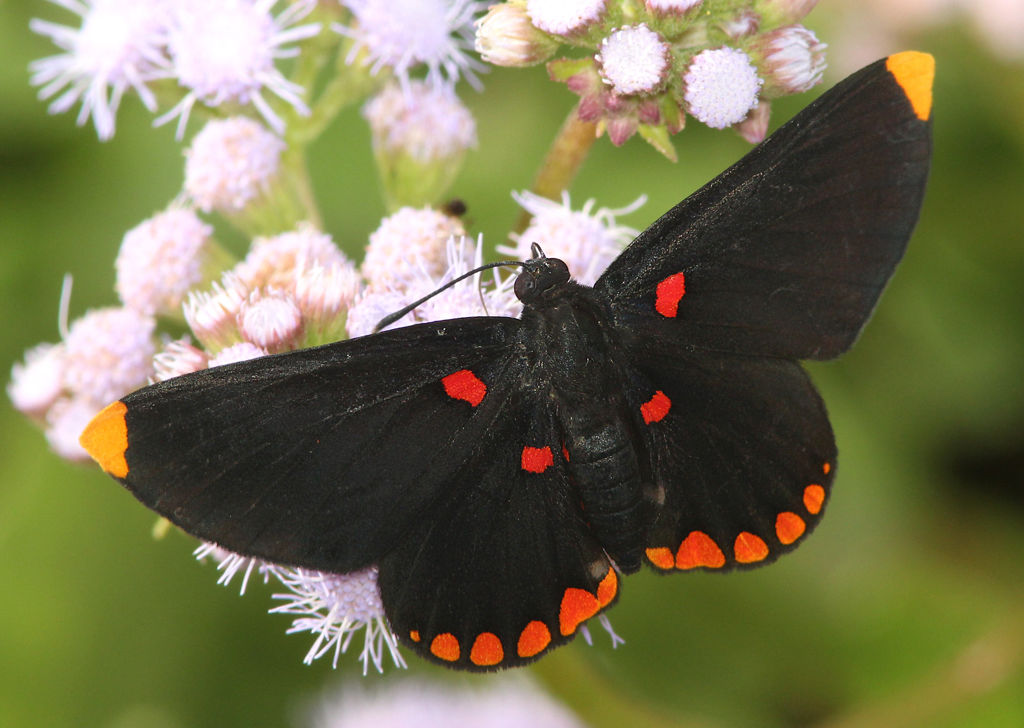
Numbers of species. Due to their bright colors and visits to flowers, butterflies are the most familiar of insects to humans. There are about 17,500 species of butterflies in the world, and around 750 species in the United States.
Classification. Butterflies are currently, with some arguments, placed into the following six families:
Hesperiidae. Known as “Skippers,” containing relatively small, fast-flying species. About 3,000 worldwide species.
Lycaenidae. Blues, Hairstreaks and Coppers. Colors and patterns of sexes often differ. Over 5,000 world species.
Nymphalidae. Known as “Brush-footed” butterflies, contains many subfamilies. There are some 5,000 worldwide species.
Papilionidae. Known as “Swallowtail, butterflies, most species have prominent “tails.” Some 600 species in the world.
Pieridae. Known as “Yellows and Whites, they have those colors predominantly. More than 1,000 worldwide species.
Riodinidae. Known as metalmarks, are sometimes placed in the Family Lycaenidae. About 1,000 species in the world.
The Lepidoptera Collection of the Smithsonian’s National Museum of Natural History has over 4 million specimens—including butterflies, moths, and skippers.
There are more than 160,000 species of butterfly around the world, learn more about this iconic insect.
Why butterflies matter
Butterflies conjure up images of sunshine, the warmth and colour of flowery meadows, and summer gardens teaming with life. Sadly, four butterflies became extinct during the last 150 years. Three-quarters of British butterflies are in decline.
The 56 species in Britain and Ireland are under threat today from unprecedented environmental change. Butterflies and moths have been recognised by the Government as indicators of biodiversity. Their fragility makes them quick to react to change so their struggle to survive is a serious warning about our environment.
Habitats have been destroyed on a massive scale, and now patterns of climate and weather are shifting unpredictably in response to pollution of the atmosphere but the disappearance of these beautiful creatures is more serious than just a loss of colour in the countryside.
Why butterflies and moths are important
There are many reasons why butterflies and moths are important, both in their own right but also as quality of life indicators. The following are the main reasons for conserving butterflies and moths in the UK and around the world.
Intrinsic value
- Butterflies and moths are intrinsically valuable and are worthy of conservation in their own right.
- Butterflies and moths are part of Life on Earth and an important component of its rich biodiversity.
- They have been around for at least 50 million years and probably first evolved some 150 million years ago.
- Butterflies and moths are a highly diverse group comprising over 250,000 species and make up around one quarter of all named species.
- Butterflies are flagship species for conservation in general, and in particular for invertebrates.
Aesthetic value
Butterflies and moths are part of our natural heritage and have been studied for over 300 years.
Butterflies and moths are beautiful. Many are iconic and popular.
People like butterflies.
There are many references to butterflies and moths in literature, from the Bible through Shakespeare to modern day literature, and from poetry to musical lyrics.
Butterflies are used by advertisers and illustrators the world over as way of indicating that something is environmentally friendly.
Butterflies are often portrayed as the essence of nature or as representing freedom, beauty or peace.
Educational value
- Butterflies and moths have fascinating life-cycles that are used in many countries to teach children about the natural world. The transformation from egg to caterpillar to chrysalis is one of the wonders of nature.
- Other educational aspects include the intricate wing patterns and iridescence, and as examples of insect migration.
Scientific value
- Butterflies (and moths to a lesser extent) are an extremely important group of ‘model’ organisms used, for centuries, to investigate many areas of biological research, including such diverse fields as navigation, pest control, embryology, mimicry, evolution, genetics, population dynamics and biodiversity conservation.
- The long history and popularity of butterfly study have provided a unique data resource on an insect group unmatched in geographical scale and timescale anywhere in the world. This has proved extremely important for scientific research on climate change.
Health value
People enjoy seeing butterflies both around their homes and in the countryside.
Over 10,000 people record butterflies and moths in the UK alone, involving getting outside and walking considerable distances. Over 850 sites are monitored each week in the UK and collectively volunteers have walked the equivalent of the distance to the moon counting butterflies.
Several hundreds of thousands of people garden for wildlife in the UK, many of them specifically for butterflies and moths.
Economic value
Thousands of people travel abroad each year looking for butterflies and moths. Eco-tours bring valuable income to many European countries and developing countries around the world (e.g. the valley of the butterflies in Rhodes and the Monarch roost in Mexico).
Every butterfly and moth has developed its own suite of chemicals to deter predators and parasites, find a mate, and overcome the chemical defences of its host plant. Each of these chemicals has a potential value and could be exploited economically.

